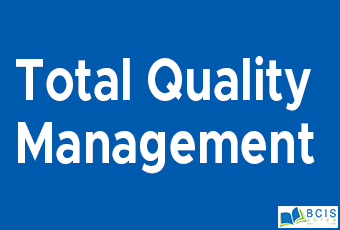
Total Quality Management
Total quality management consists of organization-wide efforts to “install and make permanent climate where employees continuously improve their ability to provide on-demand products and services that customers will find of particular value.”
Concept
Total Quality management is defined as a continuous effort by the management as well as employees of a particular organization to ensure long term customer loyalty and customer satisfaction. Remember, one happy and satisfied customer brings ten new customers along with him whereas one disappointed individual will spread bad word of mouth and spoil several of your existing as well as potential customers. You need to give something extra to your customers to expect loyalty in return. Quality can be measured in terms of durability, reliability, usage and so on. Total quality management is a structured effort by employees to continuously improve the quality of their products and services through proper feedbacks and research. Ensuring superior quality of a product or service is not the responsibility of a single member. Total quality management ensures that every single employee is working towards the improvement of work culture, processes, services, systems and so on to ensure long term success.
By definition, Total Quality Management is an approach that ensures all members of staff play a part in improving the process, products, services, and culture of work. Total Quality Management principles are usually employed at the frontline level were clerical, production and low-level managers are very much involved.
Techniques of Total Quality Management
The concept of TQM (Total Quality Management) is generally understood, and often also described, as some form of ‘ management philosophy’ based on a number of core values, such as customer focus, continuous improvement, process orientation, everybody’s commitment, fast response, result orientation and learn from others. Some of the techniques are as follows:
- BENCHMARKING: Benchmarking is the practice of comparing business processes and performance metrics to industry bests and best practices from other companies. Dimensions typically measured are quality, time and cost. Benchmarking is used to measure performance using a specific indicator (cost per unit of measure, productivity per unit of measure, a cycle time of x per unit of measure or defects per unit of measure) resulting in a metric of performance that is then compared to others. Also referred to as “best practice benchmarking” or “process benchmarking”, this process is used in management in which organizations evaluate various aspects of their processes in relation to best-practice companies’ processes, usually within a peer group defined for the purposes of comparison. This then allows organizations to develop plans on how to make improvements or adapt specific best practices, usually with the aim of increasing some aspect of performance. Benchmarking may be a one-off event but is often treated as a continuous process in which organizations continually seek to improve their practices. It can also support the selection, planning, and delivery of projects.
- RESPONSIVENESS: Responsiveness is the ability of a system or process to complete tasks within a given time frame. If customers are made to wait, they are turned into inventory, potentially resulting in unpleasant customer experience. Any customer waiting time is also an indicator of a mismatch between supply and demand. The responsiveness of management is another important technique of TQM. To survive and win, the organization have to gain adventure over their competitions. Thus, the fundamental success drivers are quality, cost competitiveness, innovation, and responsiveness.
- OUTSOURCING: Outsourcing is the business practice of hiring a party outside a company to perform services and create goods that traditionally were performed in-house by the company’s own employees and staff. Outsourcing is a practice usually undertaken by companies as a cost-cutting measure. As such, it can affect a wide range of jobs, ranging from customer support to manufacturing to the back office.
- QUALITY CIRCLES: A quality circle is a participatory management technique that enlists the help of employees in solving problems related to their own jobs. Circles are formed of employees working together in an operation who meet at intervals to discuss problems of quality and to devise solutions for improvements. Quality circles have an autonomous character, are usually small, and are led by a supervisor or a senior worker. Employees who participate in quality circles usually receive training in formal problem-solving methods—such as brainstorming, Pareto analysis, and cause-and-effect diagrams and are then encouraged to apply these methods either to specific or general company problems. After completing an analysis, they often present their findings to management and then handle the implementation of approved solutions.
- SIX SIGMA: Six Sigma streamlines quality control in an effort to improve current processes, products or services. Six Sigma is a quality management methodology used to help businesses improve current processes, products or services by discovering and eliminating defects. The goal is to streamline quality control in manufacturing or business processes so there is little to no variance throughout.
- KAIZEN: Kaizen is an approach to creating continuous improvement based on the idea that small, ongoing positive changes can reap major improvements. Typically, it is based on cooperation and commitment and stands in contrast to approaches that use radical changes or top-down edicts to achieve transformation. Kaizen is core to lean manufacturing or The Toyota Way. It was developed in the manufacturing sector to lower defects, eliminate waste, boost productivity, encourage worker purpose and accountability, and promote innovation.
You may also like: Quality Control

Leave a Reply